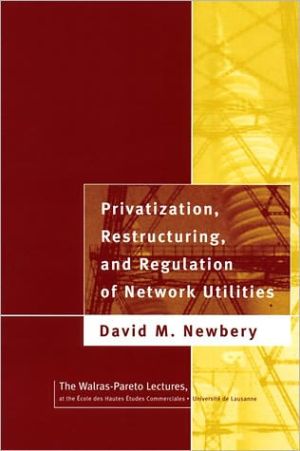

 |

|

Sold Out
Book Categories |
Preface
Abbreviation and Units
1 Introduction
1.1 Privatization in Britain
1.2 U.K. Privatization Program
1.3 Property Rights, Structure, and Efficiency
1.4 Ownership and the Boundaries of the State
Appendix: Enterprises Privatized, 1979 to 1994
2 The Problem of Regulatory Commitment
2.1 Modeling the Regulatory Compact as a Game
2.2 Playing the Game: Commitment, Credibility, and Repetition
2.3 RateofReturn Regulation
2.4 Price Regulation
2.5 Design of Regulatory Institutions
2.6 Role of Licenses in U.K. Utility Regulation
2.7 Privatization and Regulation in Transitional Economies
2.8 Conclusions
Appendix A: Modeling Regulation as a Dynamic Game
Appendix B: U.K. Legislative Framework for Telecoms and
Electricity
3 Ownership of Network Utilities
3.1 Local Utilities and Municipal Ownership
3.2 Nationwide Network Utilities
3.3 Macroeconomic Performance of Public Enterprises
3.4 Efficiency of Public and Privately Owned Network Utilities
Appendix: Evaluating Distributional Impacts
4 Theories of Regulation
4.1 Normative and Positive Theories of Regulation
4.2 Interest Group Influence on the English Electricity Industry
4.3 Dynamics of Regulatory Reform in the Bell Telephone System
4.4 Assessment of the Dynamics of Regulatory Change
4.5 Competition versus Regulation
5 Introducing Competition into Network Utilities
5.1 State Ownership and Competition
5.2 Liberalizing Entry while Retaining State Ownership
5.3 Procompetitive Reforms of StateOwned Utilities
5.4 The Case for State Ownership of the Network
5.5 Assessment of Competition and State Ownership
5.6 VerticalSeparation or Liberalized Access?
6 Reforming the Electricity Supply Industry
6.1 Vertical Separation in Electricity: The English Example
6.2 Creating Markets for Electricity
6.3 Restructuring the CEGB and the Creation of the Electricity
Pool
6.4 Was the Restructuring of the CEGB Worth It?
6.5 Creating Electricity Markets in Other Countries
6.6 Electricity Markets: Lessons from the Case Studies
6.7 Conclusions
Appendix: Modeling the Electricity Pool
7 Liberalizing the Telecommunications Industry
7.1 Pricing and Regulatory Inefficiencies
7.2 Distinctive Features of the Telecoms Industry
7.3 Possibility of Competition
7.4 Lessons to Be Drawn
7.5 Conclusions
Appendix: Telecoms Costs and TELRIC
8 Deregulation and Restructuring in Gas
8.1 Similarities and Differences between Gas and Electricity
8.2 Experience of Liberalization in the United States
8.3 Restructuring British Gas
8.4 Gas Liberalization on the Continent
8.5 Conclusions
9 Conclusions
9.1 Restructuring Network Utilities
9.2 Entry
9.3 Institutional Innovations Needed for Liberalization
9.4 Dispute Resolution
9.5 Differences between the Network Utilities
9.6 End of Regulation?
Appendix: Excess Entry in Oligopolies
Notes
References
Index
Login|Complaints|Blog|Games|Digital Media|Souls|Obituary|Contact Us|FAQ
CAN'T FIND WHAT YOU'RE LOOKING FOR? CLICK HERE!!! X
 You must be logged in to add to WishlistX
 This item is in your Wish ListX
 This item is in your CollectionPrivatization, Restructuring and Regulation of Network Utilities
X
 This Item is in Your InventoryPrivatization, Restructuring and Regulation of Network Utilities
X
 You must be logged in to review the productsX
 X
 X

Add Privatization, Restructuring and Regulation of Network Utilities, Network utilities, such as electricity, telephones, and gas, are public utilities that require a fixed network to deliver their services. Because consumers have no choice of network,they risk exploitation by network owners. Once invested, however, a netwo, Privatization, Restructuring and Regulation of Network Utilities to the inventory that you are selling on WonderClubX
 X

Add Privatization, Restructuring and Regulation of Network Utilities, Network utilities, such as electricity, telephones, and gas, are public utilities that require a fixed network to deliver their services. Because consumers have no choice of network,they risk exploitation by network owners. Once invested, however, a netwo, Privatization, Restructuring and Regulation of Network Utilities to your collection on WonderClub |